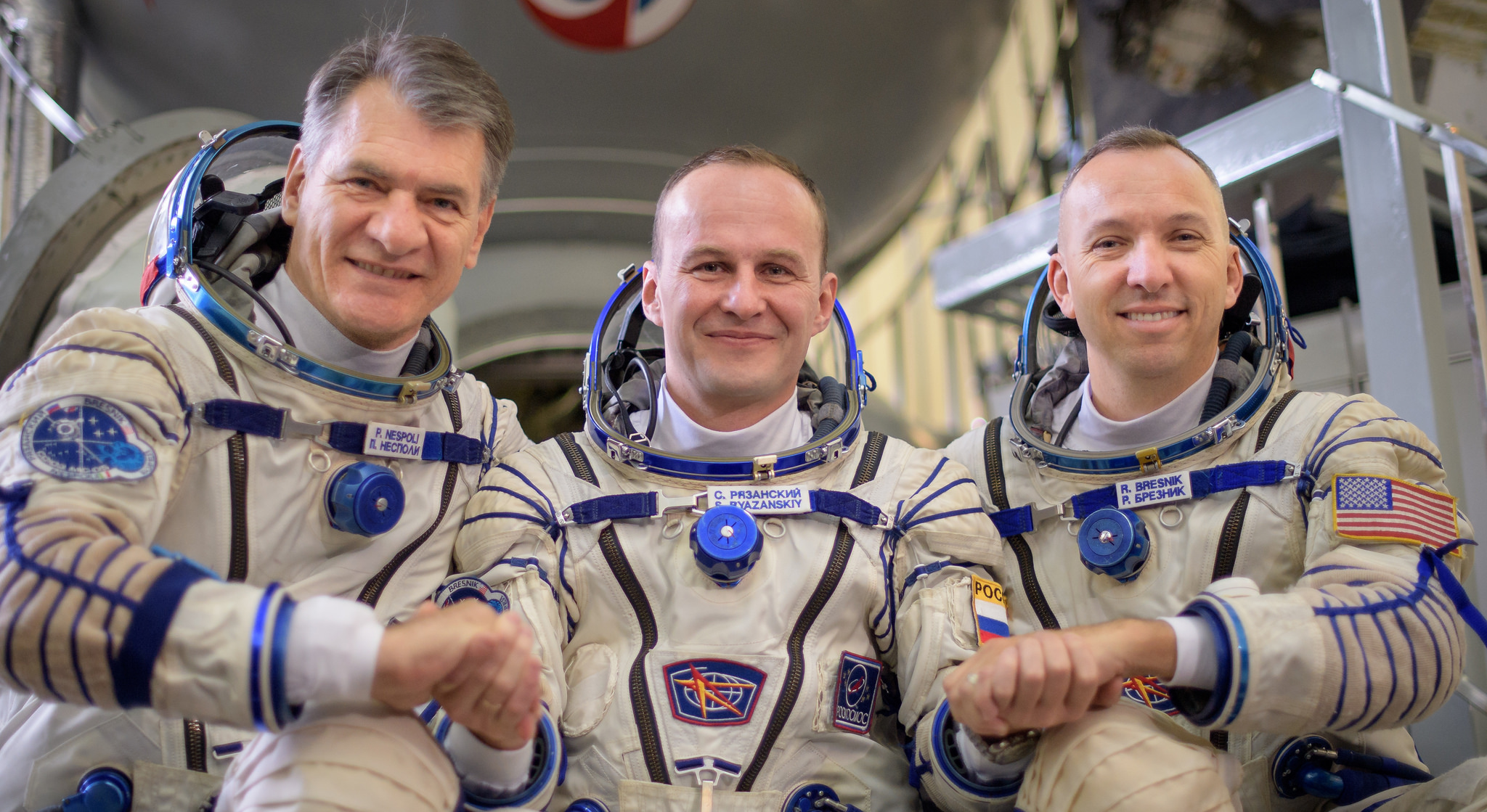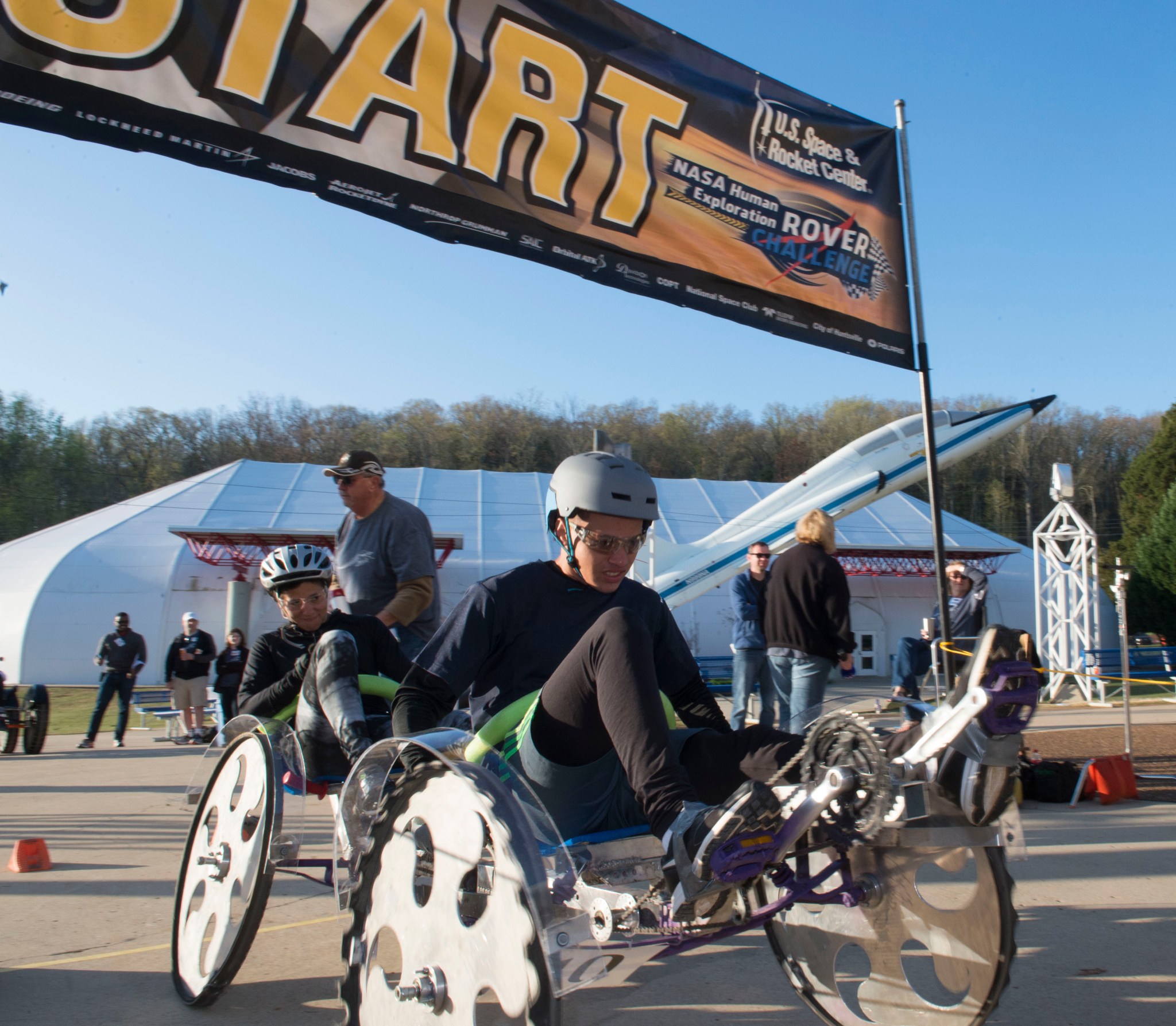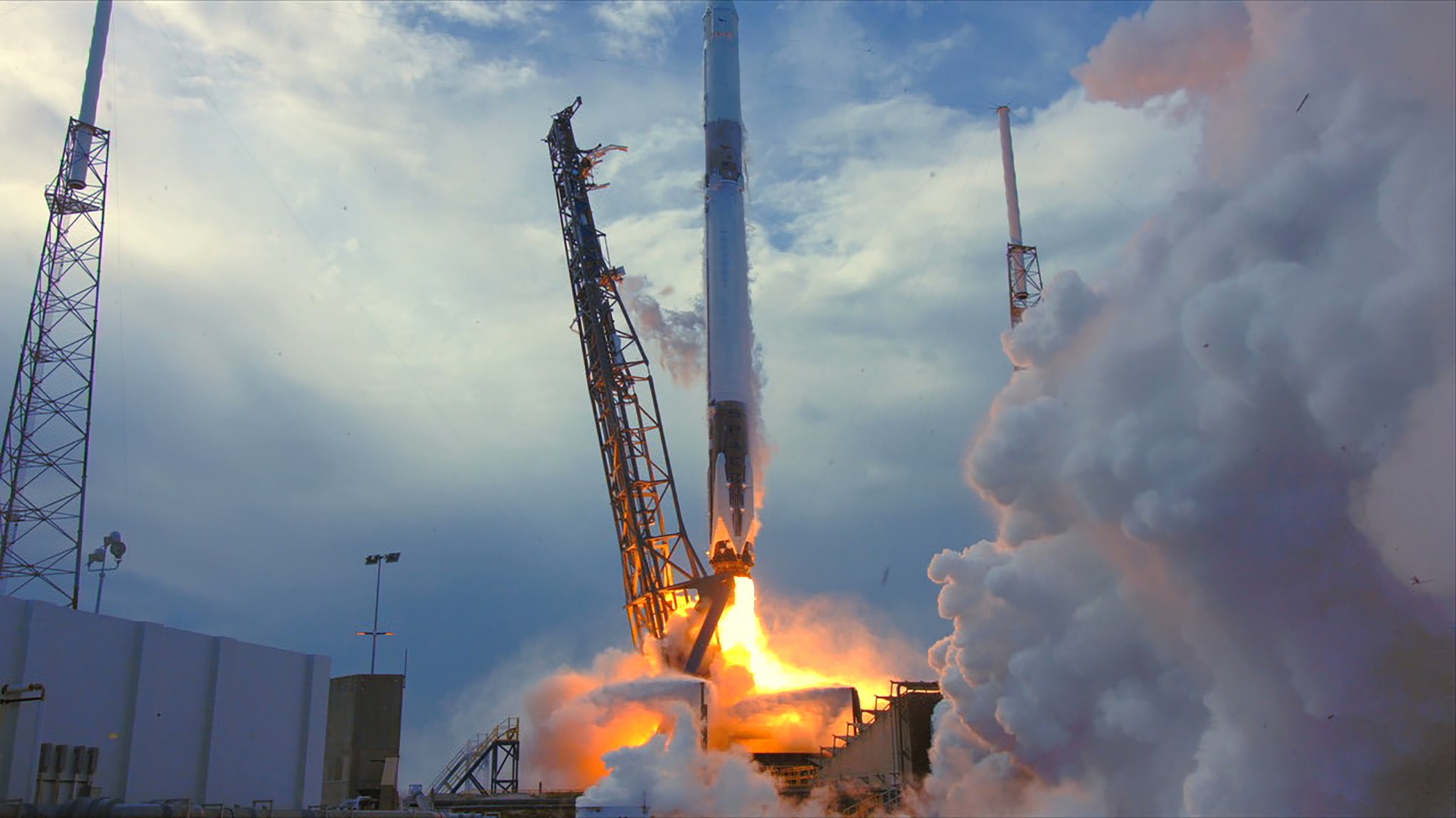In This Week’s Star
- NASA’s Super Guppy Transports SLS Flight Hardware to Kennedy Space Center
- Student Launch Teams Rendezvous in Huntsville for NASA Competition
- NASA Astronaut Randy Bresnik, ESA Astronaut Paulo Nespoli to visit Marshall April 6
- NASA Announces Teams, New Rules for 2018 Human Exploration Rover Challenge
- Expedition 55 Crew Completes Fourth Spacewalk of 2018
- SpaceX Successfully Launches Cargo Ship to Space Station Rendezvous April 2
- Marshall Engineers Honored with Golden Eagle Award for Involvement with Engine Anomaly Investigation
- Marshall Wins First Place in Team Redstone Women’s History Month Contest
- This Week in NASA History: STS-41C Launches – April 6, 1984
- Obituaries
NASA’s Super Guppy Transports SLS Flight Hardware to Kennedy Space Center
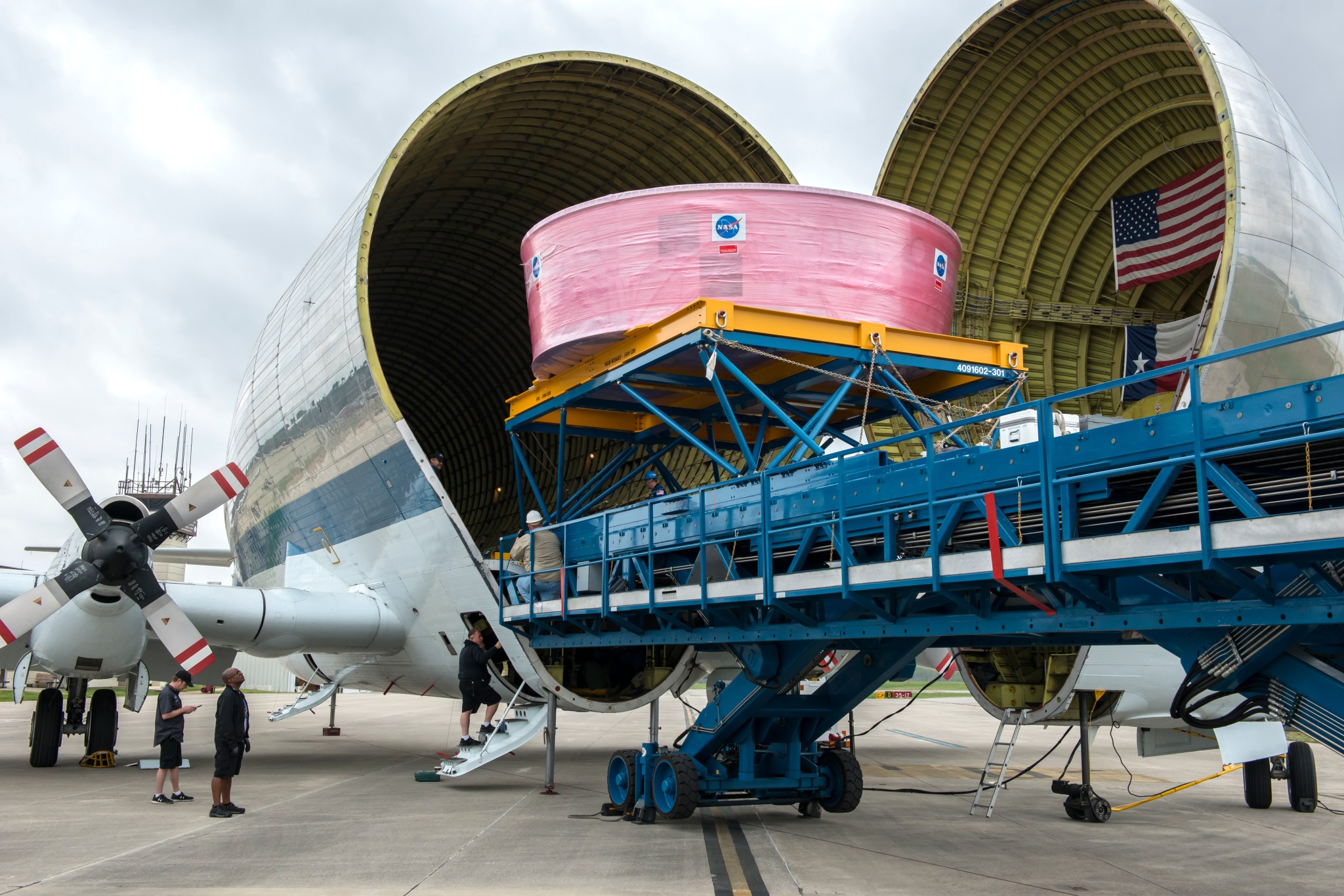
NASA’s Super Guppy aircraft prepares to depart the U.S. Army’s Redstone Airfield April 3, with flight hardware for NASA’s Space Launch System — the agency’s new, deep-space rocket that will enable astronauts to begin their journey to explore destinations far into the solar system. The Orion stage adapter, the top of the rocket that connects SLS to Orion is loaded into the Guppy, which will deliver it to NASA’s Kennedy Space Center for flight preparations. On Exploration Mission-1, the first integrated flight of SLS and the Orion spacecraft, the adapter will carry 13 CubeSats as secondary payloads. SLS will send Orion beyond the Moon, about 280,000 miles from Earth. This is farther from Earth than any spacecraft built for humans has ever traveled. (NASA/Marshall/Fred Deaton)
Student Launch Teams Rendezvous in Huntsville for NASA Competition
By Will Bryan
Week-long Schedule of Events:
- April 6: Rocket Fair, from 4 to 6:30 p.m. at Von Braun Center East Hall
- April 7: Launch Day, from 8 a.m. to 2:30 p.m. (or until last rocket launches) at Bragg Farms in Toney, Alabama
- April 7: Awards Banquet, from 5 to 7 p.m. at the U.S. Space & Rocket Center’s Davidson Center
- April 8: Tentative rain day in case of severe weather, from 8 a.m. to 2:30 p.m. (or until the last rocket launches) at Bragg Farms
NASA Marshall Space Flight Center team members, families and friends are invited to watch as 54 student teams compete in NASA’s 18th annual Student Launch on April 7.
Middle school, high school, college and university teams from 23 states will launch their student-built rockets from Bragg Farms in Toney, Alabama. Each rocket is designed to fly to an altitude of 5,280 feet, or 1 mile, deploy an automated parachute system and safely land. Each rocket will also carry a student-built payload. High school and middle school teams designed their own science or engineering payload, while college and university teams tackled one of three Marshall-defined technical payload challenges.
In preparation for launch, students will participate in a Rocket Fair from 4 to 6:30 p.m. on April 6, at the Von Braun Center’s East Hall in downtown Huntsville. Teams will showcase their rockets’ designs and payloads. The event is free and open to the public.
Following the launches, the week’s events will conclude with an awards banquet, sponsored by Orbital ATK, from 5 to 7 p.m. on April 7, at the Davidson Center for Space Exploration at the U.S. Space & Rocket Center in Huntsville.
Student Launch is a research-based, experiential activity requiring an eight-month commitment from students to design, fabricate, test and launch a rocket, as well as complete a series of real-world comprehensive flight reviews, all overseen by NASA staff, engineers and scientists.
NASA and Orbital ATK provide awards in areas such as Best Design, Altitude, Safety and others, and Orbital ATK provides an overall cash prize of $5,000 to the highest-ranking college/university team. The Huntsville chapter of the National Space Club provides a $2,500 award to the second-place team.
The Academic Affairs Office at Marshall manages Student Launch, working to reach NASA’s major education goal of attracting and encouraging students to pursue degrees and careers in the STEM fields of science, technology, engineering and mathematics.
NASA’s Office of Education, NASA’s Human Exploration and Operations Mission Directorate, Orbital ATK’s Propulsion Systems Division of Promontory, Utah, and the National Space Club of Huntsville provide funding and leadership.
If you are interested in volunteering on launch day, contact Ryan Connelly.
The rocket launches are open to the public and will stream live online at: https://www.facebook.com/NASAStudentLaunch/
For more details, rules, photos from previous events, and links to social media accounts providing real-time updates, visit: https://www.nasa.gov/education/studentlaunch
Bryan, an ASRC Federal/Analytical Services employee, supports the Office of Strategic Analysis & Communications.
NASA Astronaut Randy Bresnik, ESA Astronaut Paulo Nespoli to visit Marshall April 6
NASA astronaut Randy Bresnik and European Space Agency astronaut Paolo Nespoli, who both lived and worked on the International Space Station from July to December 2017, will visit NASA’s Marshall Space Flight Center on April 6. Bresnik and Nespoli will share highlights from their mission to space as part of the Expedition 52 and 53 crews and take questions from the Marshall workforce, beginning at 9 a.m. in Morris Auditorium, Building 4200.
Bresnik most recently served as commander of the International Space Station for Expedition 53 and flight engineer for Expedition 52, but he’s also a veteran of the STS-129 mission. He has trained as a cave-a-naut with the European Space Agency to test living deep beneath Earth’s surface, as well as an aquanaut for NASA’s Extreme Environment Mission Operation 19.
Nespoli completed more than 60 experiments during his VITA mission, which stands for Vitality, Innovation, Technology and Ability. He returned in December 2017 after 139 days in space, making him the second-most experienced ESA astronaut, with 313 days in space over three flights.
During the mission the crew worked more than 300 scientific experiments and investigations, worked with four different visiting space vehicles, and conducted four spacewalks. Bresnik performed three spacewalks totaling 20 hours and 10 minutes. His spacewalk experience is now five extra vehicular activities for a total of 32 hours outside in the void of space. The crew also took more than 800,000 photographs of the earth and inside the station during the two expeditions. Expedition 52/53 was completed in 139 days, completing 2,224 orbits of Earth.
NASA Announces Teams, New Rules for 2018 Human Exploration Rover Challenge
By Brian C. Massey
Teams from around the globe will compete April 13-14 in NASA’s Human Exploration Rover Challenge at the U.S. Space & Rocket Center in Huntsville.
The competition, hosted by NASA’s Marshall Space Flight Center, challenges high school and college teams to design, build and test human-powered roving vehicles inspired by the Apollo lunar missions and future exploration missions to the Moon, Mars and beyond.
More than 100 teams are expected to participate, including teams from 23 states, the District of Columbia, Puerto Rico, and several countries, such as Brazil, Germany, India and Mexico.
Entering its 24th year of competition, the rules and challenges for Rover Challenge have been redesigned in 2018 to better simulate a real exploration mission. Once focused on the fastest time, this year’s competition will challenge teams to complete 14 obstacles and five tasks throughout the half-mile course, with a six-minute supply of “virtual” oxygen.
The obstacles will simulate the terrain found throughout the solar system, and the tasks will challenge teams to collect and return samples, take photographs and plant a flag. Teams must decide which tasks and obstacles to attempt or bypass before their clock expires.
“NASA is committed to inspiring students in the STEM fields of science, technology, engineering and mathematics. This competition challenges our next generation of explorers to solve the problems encountered during an exploration mission,” said Mona Miller of Marshall’s Academic Affairs Office. “It’s amazing to see what these bright, young minds can accomplish.”
Each rover will be driven by one male and one female team member, and teams will compete for the top three finishers, best overall design, rookie team and other technical challenges. Corporate sponsors will present the prizes following the competition at the annual awards ceremony.
Major corporate sponsors include: The Boeing Co.; Jacobs Engineering; Lockheed Martin Corp.; and Northrop Grumman Corp., all with operations in Huntsville.
Other contributors include: Aerojet Rocketdyne, headquartered in Sacramento, California; Aetos Systems of Huntsville; AI Signal Research Inc. of Huntsville; the American Institute of Aeronautics and Astronautics, Greater Huntsville Section; the City of Huntsville; Corporate Office Properties Trust, headquartered in Columbia, Maryland; Currie Systems of Huntsville; Davidson Technologies of Huntsville; Geocent of Huntsville; Huntsville/Madison County Convention & Visitors Bureau; International System Safety Society, Tennessee Valley Chapter; the National Space Club of Huntsville; McDonald Scales Inc. of Huntsville; MSB Analytics Inc. of Huntsville; MTS Inc. of Huntsville; National Defense Industrial Association, headquartered in Arlington, Virginia; Orbital ATK of Dulles, Virginia; Redstone Federal Credit Union of Huntsville; Science Applications International Corp. of Huntsville; Teledyne Engineering of Huntsville; the Tennessee Valley Chapter of the System Safety Society; the U.S. Space & Rocket Center; United Research Services of San Francisco; and the University of Alabama in Huntsville.
Teams will arrive in Huntsville April 12 for on-site registration, with the race taking place 7:30 a.m. to 5 p.m. CDT, April 13-14. The two-day event and awards ceremony will be broadcast live on a variety of streaming platforms, including Facebook Live, Periscope and Ustream.
Massey, an ASRC Federal/Analytical Services employee, supports the Office of Strategic Analysis & Communications.
Expedition 55 Crew Completes Fourth Spacewalk of 2018
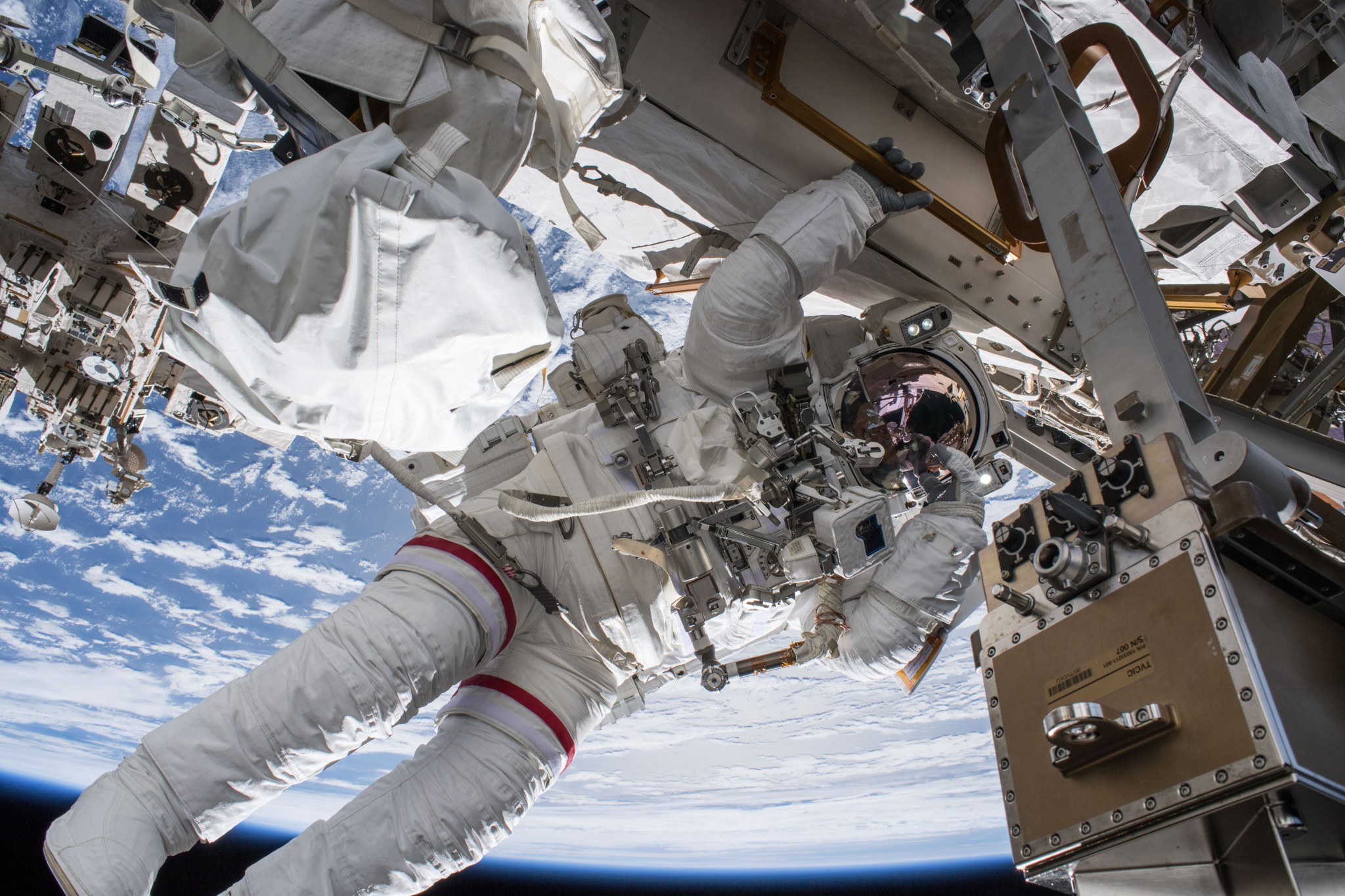
Expedition 55 Flight Engineer Drew Feustel works on completing a task during an extra vehicular activity outside the International Space Station on March 29. Feutsel and fellow NASA astronaut Ricky Arnold completed the fourth spacewalk outside the station of 2018 at 2:43 p.m. CDT, March 29, lasting 6 hours, 10 minutes. The two astronauts installed wireless communications antennas on the Tranquility module, replaced a camera system on the port truss and removed suspect hoses from a cooling system. Spacewalkers have now spent a total of 54 days and 10 hours working outside the station in support of assembly and maintenance of the orbiting laboratory. (NASA)
SpaceX Successfully Launches Cargo Ship to Space Station Rendezvous April 2
SpaceX launched its 14th resupply mission to the International Space Station April 2, with the successful liftoff at 3:30 p.m. CDT of a Falcon 9 rocket carrying a Dragon cargo ship to orbit. Scheduled to dock with the station April 4, the Dragon was packed with more than 5,800 pounds of food, supplies, research investigations and equipment — including NASA’s Atmosphere-Space Interactions Monitor, a suite of cameras and instruments set to study lightning in the upper atmosphere, helping researchers establish the relationship between such lightning and Earth’s climate. The April 2 launch marks the first time SpaceX has reused a lifting rocket and cargo vessel together at the same time. The Falcon 9’s first stage previously hauled the commercial firm’s 12th cargo resupply mission to orbit in August 2017; the Dragon vessel last flew in April 2016, during SpaceX’s eighth resupply mission. The cargo ship will spend roughly one month docked at the station before it detaches for its return to Earth. (NASA)
Marshall Engineers Honored with Golden Eagle Award for Involvement with Engine Anomaly Investigation
By Morgan MacMillan
At NASA’s Marshall Space Flight Center, safety is paramount. Every team member has a role in ensuring safety and the success of the agency’s missions.
The Golden Eagle award, part of the Marshall’s Mission Success is in Our Hands initiative, aims to promote awareness and appreciation for the connections between employees’ everyday work, the success of NASA and Marshall missions and the safety of astronauts.
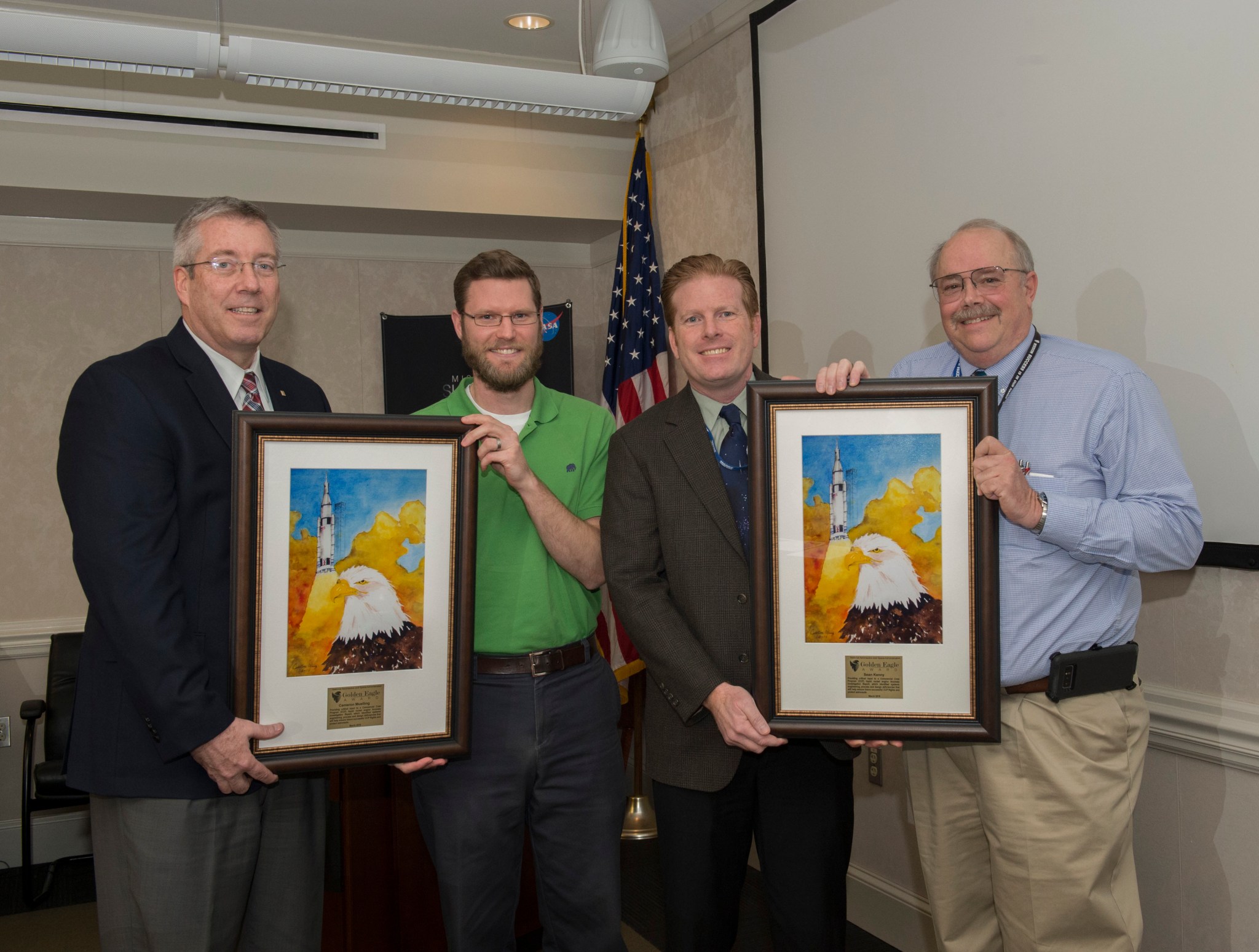
“The Golden Eagle Award recognizes individuals who have made significant contributions to flight safety and mission assurance,” said Sheryl Kittredge, Marshall Safety & Mission Assurance technical assistant. “We’re always excited to see the safety influences that come from work done here at Marshall.”
Sean Kenny and Cameron Muelling, both propulsion systems engineers, were presented the Golden Eagle Award at the March 22 Shared Experiences forum. Kenny and Muelling were recognized for their critical inputs to the Commercial Crew Program’s liquid rocket engine anomaly investigation, which identified systems engineering, process and design deficiencies that will continue to ensure future successful CCP flights and protect astronauts. Their detailed knowledge of the engine design and test procedures enabled them to provide justification for NASA to explore other failure modes beyond what had been initially concluded.
“The proprietary nature of the test results, conclusions and associated obstacles didn’t deter Kenny or Muelling from providing the necessary objective analysis,” said Ken Philippart, Engineering Services and Science Capability Augmentation contract team lead for Liquid Propulsion Systems. “Their work will help ensure safe CCP flights in the years to come and protect the lives of the astronauts who fly on them.”
All Marshall team members are eligible for the Golden Eagle Award. To nominate someone for consideration, click here.
For more information about Mission Success is in Our Hands, click here.
MacMillan, an ASRC Federal/Analytical Services employee, supports the Office of Strategic Analysis & Communications.
Marshall Wins First Place in Team Redstone Women’s History Month Contest
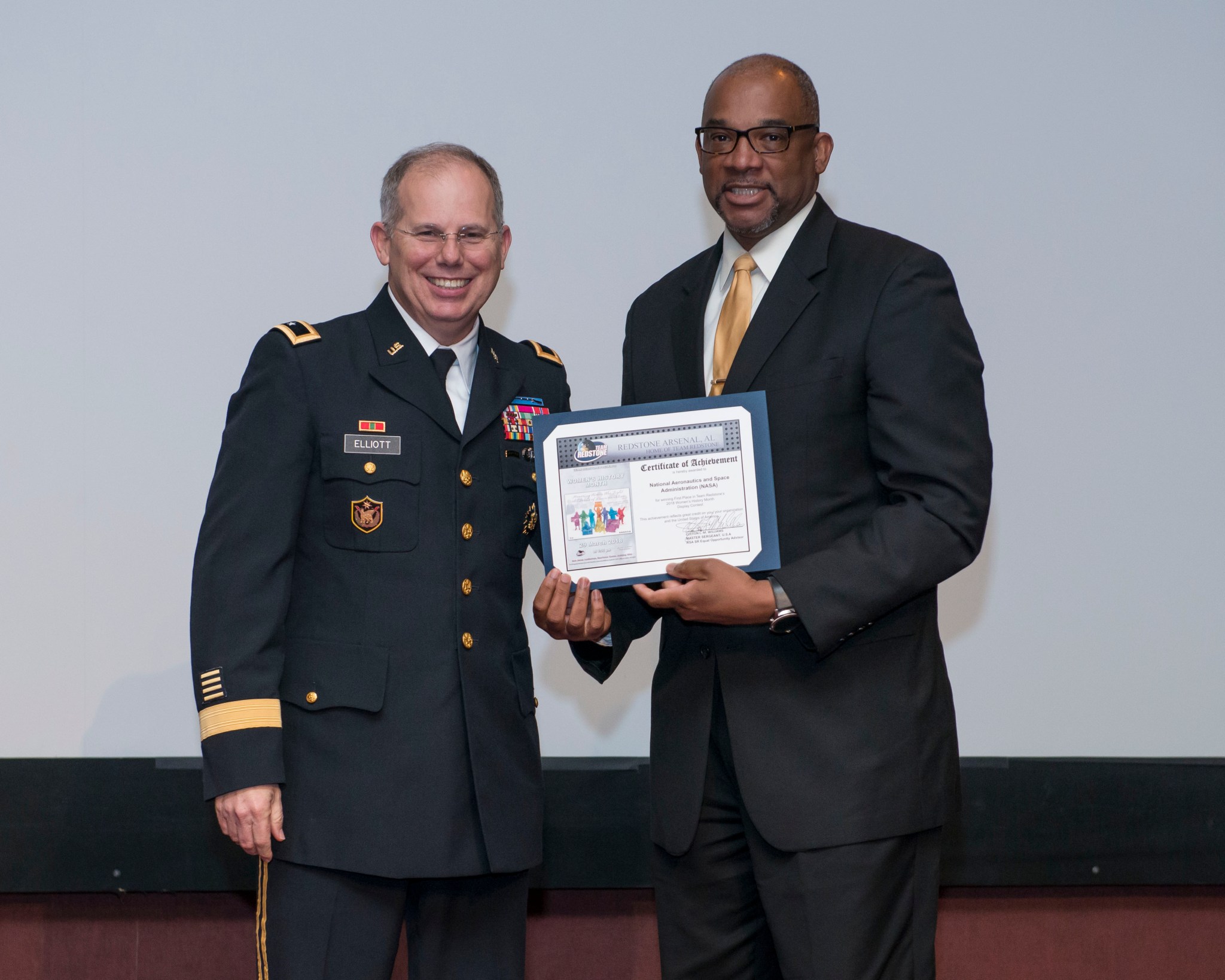
Loucious Hires, director of Marshall’s Office of Diversity and Equal Opportunity, accepts an award from Maj. Gen. Allan Elliott on behalf of the center, which won first place in the Team Redstone Women’s History Month Observance Display Contest. The display can be viewed in the lobby of Building 4200 until April 13. (NASA/MSFC/Fred Deaton)
This Week in NASA History: STS-41C Launches – April 6, 1984
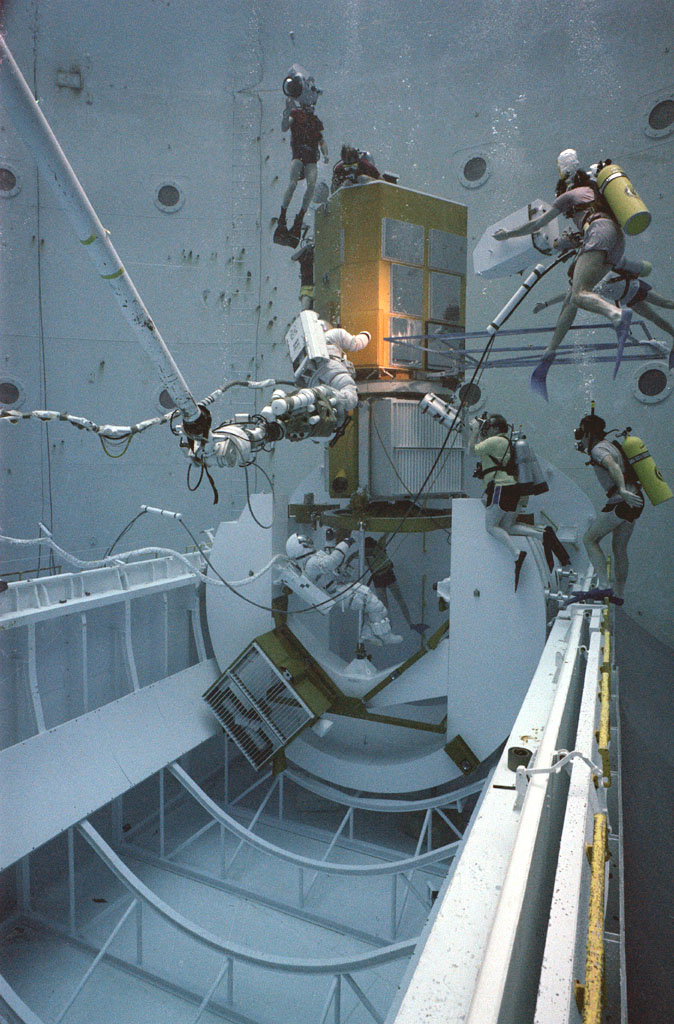
This week in 1984, space shuttle Challenger, mission STS-41C, launched from NASA’s Kennedy Space Center. The primary mission objectives were to deploy the Long Duration Exposure Facility, an orbital facility designed to test the performance of spacecraft materials, components and systems exposed to the space environment, and to capture, repair and release the Solar Max satellite. This was the first on-orbit repair of a satellite. Here, crew members train for their repair tasks in NASA Marshall Space Flight Center’s Neutral Buoyancy Simulator. The simulator prepared astronauts for extra-vehicular activities from its completion in 1968 until it was decommissioned in 1997. The NASA History Program is responsible for generating, disseminating and preserving NASA’s remarkable history and providing a comprehensive understanding of the institutional, cultural, social, political, economic, technological and scientific aspects of NASA’s activities in aeronautics and space. For more pictures like this one and to connect to NASA’s history, visit the Marshall History Program’s webpage. (NASA)
Obituaries
August R. Felix Sr., 91, of Huntsville, died March 28. He retired from the Marshall Center in 1986 as chief of the experimental aerodynamics branch. He is survived by his wife, Dorothy D. Felix.



























